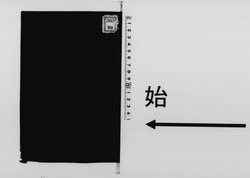File:NDL960092 海上衝突予防法詳論 part1.pdf

Original file (6,350 × 4,512 pixels, file size: 59.18 MB, MIME type: application/pdf, 100 pages)
Captions
Captions
Summary
edit| 海上衝突予防法詳論
( |
|||||||||||||||||||||||||||
|---|---|---|---|---|---|---|---|---|---|---|---|---|---|---|---|---|---|---|---|---|---|---|---|---|---|---|---|
| Author |
永嶺, 忠宜 |
||||||||||||||||||||||||||
| Title |
海上衝突予防法詳論 |
||||||||||||||||||||||||||
| Publisher |
集萃社 |
||||||||||||||||||||||||||
| Language | jpn | ||||||||||||||||||||||||||
| Publication date |
1920 大正9 |
||||||||||||||||||||||||||
| Place of publication | JP | ||||||||||||||||||||||||||
| Source |
institution QS:P195,Q477675 |
||||||||||||||||||||||||||
| Creator InfoField | 永嶺忠宜 著 | ||||||||||||||||||||||||||
| Publication Place InfoField | 神戸 | ||||||||||||||||||||||||||
| Subject: NDC InfoField | 550 | ||||||||||||||||||||||||||
| Extent InfoField | 286p ; 22cm | ||||||||||||||||||||||||||
| Material Type InfoField | Book | ||||||||||||||||||||||||||
| Source Identifier: JPNO InfoField | 43027856 | ||||||||||||||||||||||||||
| Date Digitized: W3CDTF InfoField | 2008-03-31 | ||||||||||||||||||||||||||
| Audience InfoField | 一般 | ||||||||||||||||||||||||||
| Title Transcription InfoField | カイジョウ ショウトツ ヨボウホウ ショウロン | ||||||||||||||||||||||||||
| Publisher Transcription InfoField | シュウスイシャ | ||||||||||||||||||||||||||
| Source Identifier: NDLBibID InfoField | 000000575281 | ||||||||||||||||||||||||||
| Call Number InfoField | 380-49 | ||||||||||||||||||||||||||
| Creator Transcription: NDLNA InfoField | ナガミネ, タダヨシ | ||||||||||||||||||||||||||
| Creator: NDLNAId InfoField | 00049832 | ||||||||||||||||||||||||||
| Note InfoField | 国立国会図書館内では、一部分のみ印刷できます。 | ||||||||||||||||||||||||||
| Contents InfoField | 標題
地方規程抜抄、日本主要港、東洋主要港、西洋主要港、米国内海航行規程/52p 総則、シツプとベツセル、航洋船、地方規程、汽船と帆船、航行中/1p 第一条 閃火、船灯掲揚ノ時機、紛レ易キ灯火、例外、船灯規定違反ガ衝突ノ原因トナラザル場合/6p 第二条 舷灯ノ隔板装置、船灯、舷灯が他舷ヲ照ラス角度、規則適用上ノ注意、トロール船、船灯ノ故障ト衝突、舷灯掲揚ノ位置ト衝突ノ責任/13p 第三条 曳船ノ増掲灯、被曳船ノ船尾灯、曳船ト被曳船トノ関係、目標灯、碇泊船ヲ曳航スル曳船灯、曳船信号/24p 第十条 船尾灯、横切船に対する船尾灯、閃火の一時的表示、舷灯と船尾灯、ピンナクル、ランプ、被曳船の船尾灯、後方の見張/58p 第十五条 霧中の標準、汽船の信号、帆船の信号、被曳船の信号、汽船と汽船、帆船と帆船、霧堤に接近する場合、側方の霧堤、音響の伝達、霧中号角、/74p 第十六条 適度の速力と減殺せる速力、速力を減じたる場合の汽船の汽圧、霧中信号と機関停止帆船適度の速力、渡海船、曳船、海底電信布設船、仏国委員の陳述、現時の状況、前面又は側面の霧堤、霧中帆船の義務、汽船の義務、汽船と汽船の場合、霧中の後退、運航上の注意、霧中の転針、夢中の碇泊/83p |
||||||||||||||||||||||||||
Licensing
editThis image is in the public domain because it is a mere mechanical scan or photocopy of a public domain original, or – from the available evidence – is so similar to such a scan or photocopy that no copyright protection can be expected to arise. The original itself is in the public domain for the following reason:
This tag is designed for use where there may be a need to assert that any enhancements (eg brightness, contrast, colour-matching, sharpening) are in themselves insufficiently creative to generate a new copyright. It can be used where it is unknown whether any enhancements have been made, as well as when the enhancements are clear but insufficient. For known raw unenhanced scans you can use an appropriate {{PD-old}} tag instead. For usage, see Commons:When to use the PD-scan tag. |
著作権法第67条第1項により文化庁長官裁定を受けて公開(裁定年月日: 2019/07/09)
File history
Click on a date/time to view the file as it appeared at that time.
| Date/Time | Thumbnail | Dimensions | User | Comment | |
|---|---|---|---|---|---|
| current | 15:56, 16 November 2023 |  | 6,350 × 4,512, 100 pages (59.18 MB) | Wmr-bot (talk | contribs) | 上載《960092_1.pdf》 |
You cannot overwrite this file.
File usage on Commons
The following page uses this file:
Metadata
This file contains additional information such as Exif metadata which may have been added by the digital camera, scanner, or software program used to create or digitize it. If the file has been modified from its original state, some details such as the timestamp may not fully reflect those of the original file. The timestamp is only as accurate as the clock in the camera, and it may be completely wrong.
| Short title | |
|---|---|
| Author | |
| Keywords | https://commons.wikimedia.org/wiki/Commons:Library_back_up_project |
| Conversion program | PyPDF2 |
| Encrypted | yes (print:yes copy:no change:no addNotes:no algorithm:AES-256) |
| Page size | 3048 x 2166 pts |
| Version of PDF format | 1.7 |




